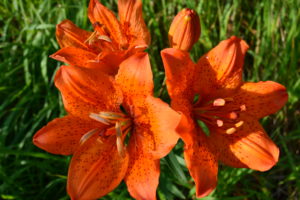Species and habitat description
Lilium bulbiferum, common names Orange lily, is a herbaceous European lily with underground bulbs, belonging to the Liliaceae. Species of remarkable beauty and showiness, extremely widespread in different environments. Biological Form: G bulb – Bulbous geophytes. Plants whose perennial organ is a bulb from which, every year, flowers and leaves are born. Lilium bulbiferum subsp. croceum reaches on average 20–80 centimeters of height. The bulbs are ovoid, with whitish large and pointed scales. The stem is erect, the leaves are lanceolate. The inflorescence has one to five short-haired flowers. The flowering period extends from May through July. The Orange lily is a species with a sub-Mediterranean mountain distribution. It can be found in meadows, subalpine vaccines, high-herb vegetation, fresh wood, wooded edges of oak, chestnut and beech woods, on loose loamy-clay soils, rich in skeleton, medium deep, preferably calcareous and with sweet humus, from the sub-Mediterranean to the sub-alpine zone.
In the Park Vena del Gesso-Romagnola is an indicated species of the phytosocological association of Laburno-Ostryon Ubaldi (1980) 1995 and together with Laburnum anagyroides a differential species; this alliance is inside the alternative of Lathyro veneti-Carpinetalia betuli (Ubaldi 2003). The alliance Laburno-Ostryon Ubaldi (1980) includes the woods of shady slopes and ravines of the Vena del Gesso-Romagnola.
Major threats
Habitat loss, human and wildlife pressure such as the destruction of bulbs by wild boars. The illegal and massive collection of scapes occurs frequently, but does not appear to be a threat. It is included in the List of Target Plant Species of Conservation Interest in the Region (2017) and it is classified as NT (almost at risk).
Specific conservation action
Orange lily is widespread all over the Apennines, included in the site IT4070011 of Parco Vena del Gesso-Romagnola. Specific conservation actions include harvesting and storing seeds in order to create a seed bank and preserve ecotypes. If necessary, resettlement of the species. Other actions consist in eliminating invasive alien species, developing a naturalistic forest management to favor oak species such as Quercus pubescens and consequently generating good habitat conditions for Orange Lily.

Related project areas
Località Gesso
Bibliography
E. Moretti (2013) : La vegetazione della vena del gesso romagnola. Carta Bianca editore, “Quaderni del Parco”. pp16-17; pp 68. www.floravenagesso.it; www.actaplantarum.org ; http://ambiente.regione.emilia-romagna.it/it/parchi-natura2000/sistema-regionale/flora/flora-protetta